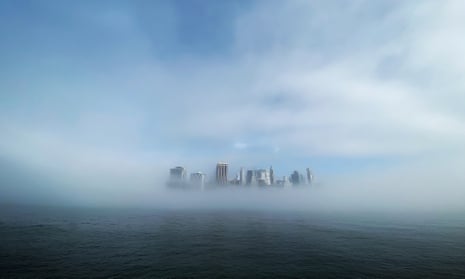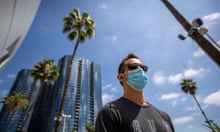In the weeks and months after the 9/11 attacks, New York City began to slowly recompose itself. The crater at Ground Zero smoldered, a great hellish cloud in the sky, but life needed to come back, and it did. Children went back to school, parents to work and baseball, after a short hiatus, returned to thrumming stadiums. If uncertainty bled into dread – when would we be attacked again? – New Yorkers weren’t going to show it for long. There was a recession, but the recession passed, and the 2000s roared on. The young continued to flock to New York’s glittering promise.
The Covid-19 pandemic is different. September 11, like the Kennedy assassination, was a single day of trauma that a generation will carry for a lifetime. Coronavirus may loom far longer, nullifying all that made New York such a glorious place to live, to grow up in. More than 20,000 New Yorkers have died, the equivalent of eight or so 9/11s. Political leadership failed disastrously. The whole urban project, at least in the darkest hours, seems in question.
New York will come back. It always does. The 1918 flu, the Great Depression, the 1970s fiscal crisis, the Aids epidemic, the destruction of the World Trade Center, the 2008 financial crash and Superstorm Sandy could not lay low New York for good. Predicting the demise of America’s biggest city, such a source of envy and fascination and resentment for the rest of the nation, is a longtime parlor game. The city is too attractive, too diverse, too overflowing with opportunity – even now – to crumble.
At the same time, New York has never encountered a crisis like this one. The city I knew, as a third-generation New Yorker, is temporarily no more. I am not going for long swims at Coney Island, playing softball in the park, or crowding into apartments for drinks.
In recent weeks, tens of thousands of New Yorkers have marched against police brutality, reclaiming streets that had been vacant. This feels like a reemergence, of sorts, and I hope the good news about declining coronavirus cases stretches deep into the year and beyond.
The city, meanwhile, has been forced to change. The 24/7 subway is gone for now, closing nightly for deep-cleans and the chasing away of homeless. Bars and restaurants and nightclubs, the lifeblood of the city and daily memory-makers, will not be able to reach their old capacity for some time. The tourism industry has been decimated. Cultural landmarks like Broadway and the Metropolitan Museum of Art are shuttered, and may struggle to draw their old crowds once reopened. If professional baseball is played in 2020, it will be in empty stadiums.
Has New York changed permanently? It’s too soon to tell. Though there is no equivalent of what coronavirus has done to the city in anyone’s lifetime, the instructive catastrophe may be 1975. That year, the city was on the brink of financial collapse after banks refused to lend the city government more money. The crisis was long in the making: white flight, the decline of local manufacturing and old-fashioned mismanagement eroded the city’s tax base.
After the state government took over the city’s finances and bankruptcy was averted, new loans came through – with conditions: devastating cuts to the social net. Hospitals and firehouses were closed, teachers and police and sanitation workers laid off en masse, and the municipal university system, once mostly tuition-free, charged students for the first time. The city contracted, with the working class and poor suffering most. The postwar social democracy of New York was no more. Neoliberalism had triumphed.
With shutdowns eviscerating New York’s once humming economy, generation-defining cuts are again on the table. This is a grim, and very possible, future. The governor, Andrew Cuomo, whose popularity belies his utter failure to impose a shelter-in-place order in time to slow the spread of the virus, is threatening to cut the state’s budget by as much as $10b, an amount with no modern precedent.
These cuts would fall especially hard on New York City, particularly the budgets for public schools and mass transit. Donald Trump and Mitch McConnell are unlikely to sanction the sort of federal aid Cuomo needs – roughly $60bn – to offset the cuts, which means Cuomo may crush the city with the sort of austerity measures that crippled European nations during last decade’s Eurocrisis.
The city, in the interim, is bound to get smaller. Some people will seek safe harbor in suburbs or rural areas. Less will ride mass transit, afraid of getting sick. Before the pandemic, as many as six million people used public transit in New York City in a single day. Those days will not return for a while. More people may choose to drive cars, clogging roadways and killing more pedestrians. And with a glaring undercount in the census, New York could lose out on future federal funding.
More telecommuting will mean challenges for the city’s commercial real estate. Manhattan is the office space capital of America. Fewer office workers and tourists in Midtown will trickle down to less business for the restaurants, food carts, pharmacies and other businesses that cater to the lunchtime surge.
One side effect of the Covid-19 crisis may actually benefit the working class and poor: falling rents. Here lies some opportunity and relief. The real estate bull market is dead and may not return for a few years, at least. Though the go-go 1980s of young Trump, Patrick Bateman and Sherman McCoy are what people usually imagine when conceiving of a reckless New York gilded age, the 2010s were the true apotheosis of greed – a housing market fed by foreign money and private equity, residential and commercial rents skyrocketing as the decade wore on.
A longtime small business could fail not because of a lack of commerce but simply due to a landlord’s decision to dramatically hike rent in the hope of attracting a Starbucks, Chase Bank or any corporate tenant that could pay the absurd asking price.
Home ownership, possible for the city’s middle class in the 20th century, was no longer attainable, with houses routinely selling for more than $1m. Escalating rents forced the non-wealthy to the fringes of the city or beyond. Landlords harassed poor tenants to drive them away and replace them with affluent newcomers. Until a 2019 law change, rent-stabilized units were aggressively deregulated, affordable housing stock disappearing for good.
This will change. If post-pandemic New York is going to be, momentarily, no longer a playground for the master class, it will tip the balance of power towards renters for the first time in decades. Landlords will cut prices in a desperate bid to attract tenants. Housing prices may decline enough for those with some cash to take advantage of near-nonexistent interest rates to buy property. The middle and working class – those who can stay employed – could find a new toehold in the 2020s, if the social safety net doesn’t vanish altogether.
Lower rents may bring about a fairer city, with poorer people able to carve out livelihoods in apartments once out of reach. Artists and musicians may discover a new Bohemia. Vacant office space, with the right investment, could be converted to housing. The moneyed, achromatic 2010s could give way to a more fascinating and unpredictable cultural landscape, with once marginalized communities asserting themselves. Out of the ashes, always, is possibility.
But we can’t undersell the crisis. New York City has never faced an existential threat like this one. The emotional and economic fallout will be with us for a long, long time. What hurts me as a lifelong New Yorker is how exceptional our city was during Covid-19 – in the worst possible sense, as our mayor and governor failed on all fronts to contain the pandemic. We must remember, as we painfully rebuild, that none of this was inevitable. We deserved better.
Ross Barkan is a writer based in New York City









